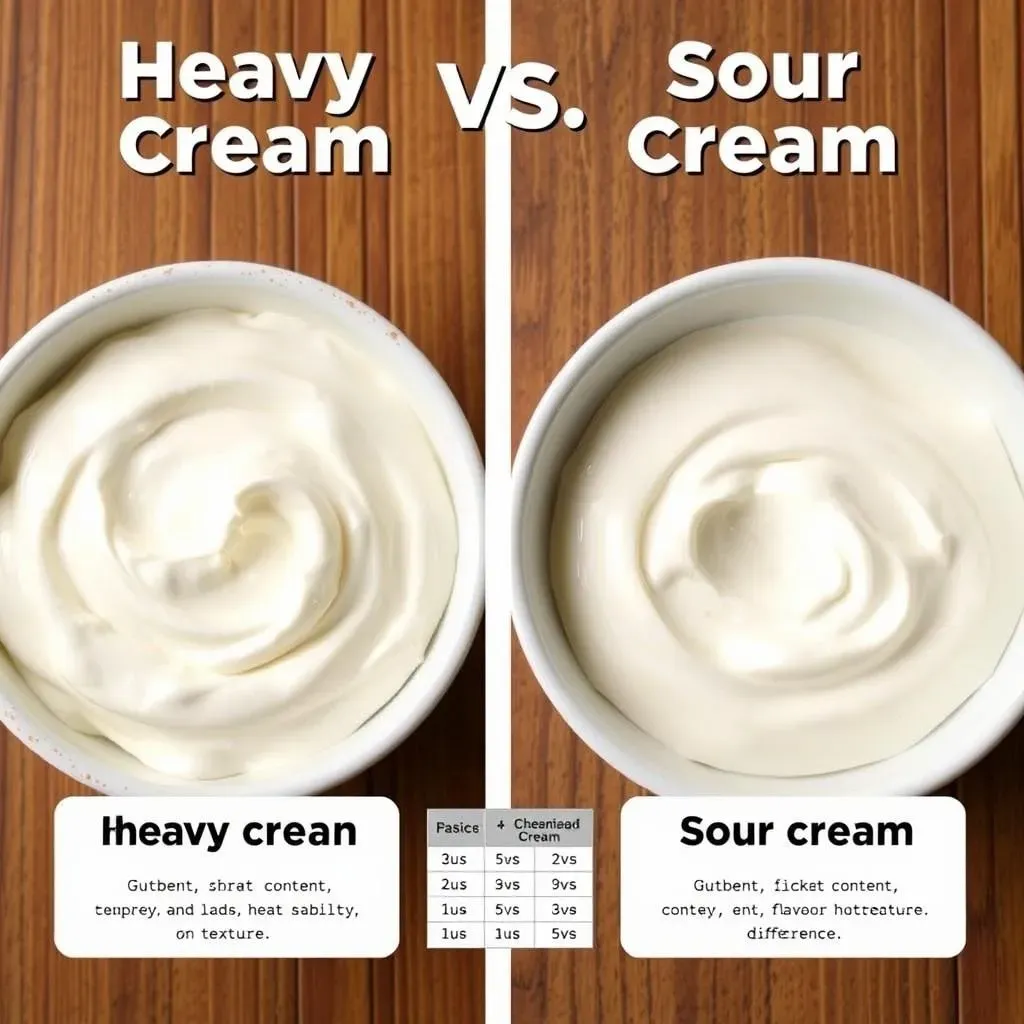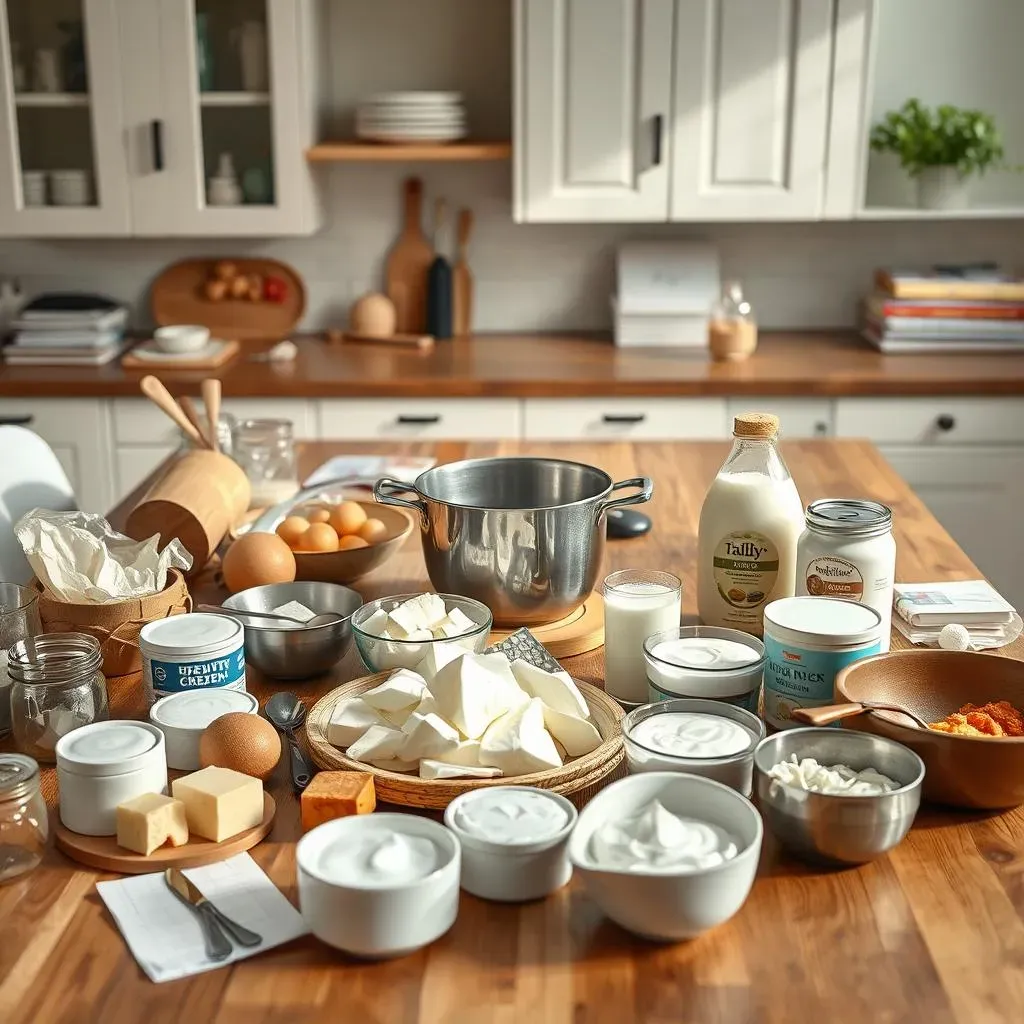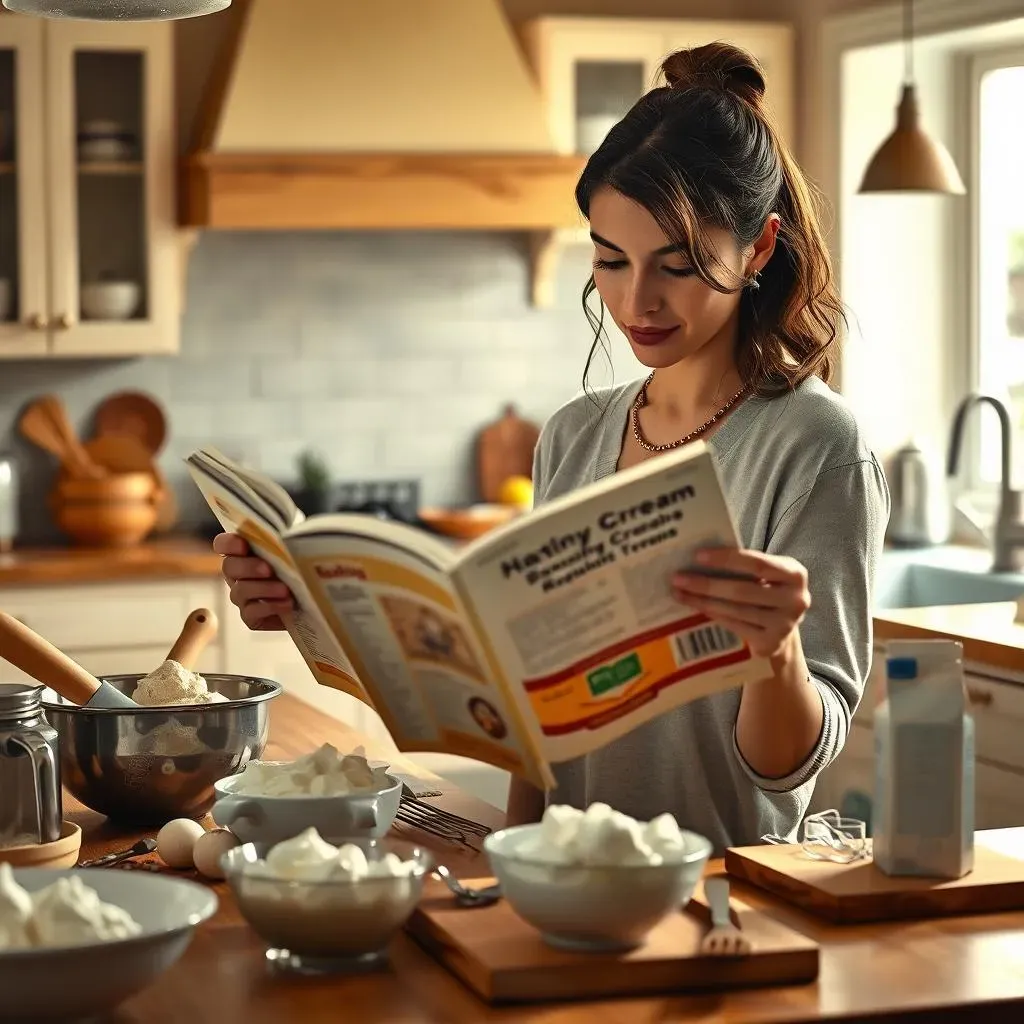Table of Contents
Ever found yourself mid-recipe, staring at an empty carton where heavy cream should be? It's a kitchen conundrum many of us face. Heavy cream is great, adding that rich, smooth texture to everything from pasta sauces to decadent desserts. But what if it's not on hand? That's where the magic of substitution comes in. Today, we're tackling a popular alternative: sour cream. Yes, that tangy dollop in your fridge can actually stand in for heavy cream in many recipes. This article is your guide to successfully substituting sour cream for heavy cream. We'll explore the key differences between these two ingredients, when it's a good idea to swap them, and when you might want to consider other options. We'll also dive into some common questions and concerns you might have, ensuring you're equipped to handle any recipe that calls for heavy cream, even if you're fresh out. So, let's get started and learn how to navigate the world of creamy alternatives!
Sour Cream vs. Heavy Cream: What's the Real Difference?

Sour Cream vs. Heavy Cream: What's the Real Difference?
The Fat Factor
so let's get down to the nitty-gritty: fat. Heavy cream is basically the heavyweight champion of dairy fat, usually clocking in at around 36% or more. This high-fat content is what gives it that super-rich, velvety texture and allows it to whip into glorious peaks. Sour cream, on the other hand, is more like the middleweight contender, typically around 20% fat. It's still creamy, but it has a tang that heavy cream doesn't possess. Think of it like this: heavy cream is the indulgent, buttery cousin, and sour cream is the slightly sassy, tangy one. They're both delicious, but they play different roles in the kitchen.
The difference in fat content also affects how they behave when heated. Heavy cream is much more stable at higher temperatures. Sour cream, because of its acidity and lower fat, can sometimes curdle or separate if it gets too hot. This is something to keep in mind when you're thinking about substituting one for the other in a recipe that involves cooking.
Flavor Profiles
Beyond the fat content, the most noticeable difference is the flavor. Heavy cream is very neutral, almost sweet. It's a blank canvas for other flavors, which is why it's so versatile in both sweet and savory dishes. Sour cream, as the name implies, has a distinct tangy taste. This is thanks to the lactic acid that forms during its fermentation process. That tang can add a lovely zing to dishes, but it's also a flavor that might not be right for everything. Think of the difference between a smooth, creamy Alfredo sauce (heavy cream) and a zesty, refreshing potato salad (sour cream). Both are amazing, but they offer completely different flavor experiences.
Feature | Heavy Cream | Sour Cream |
|---|---|---|
Fat Content | 36% or more | Around 20% |
Flavor | Neutral, slightly sweet | Tangy, acidic |
Heat Stability | High | Lower, can curdle |
Texture | Rich, velvety | Creamy, thick |
Usage and Applications
Heavy cream is your go-to for things like whipped cream, rich sauces, and decadent desserts. It's the key to those silky smooth textures and that luxurious mouthfeel. Sour cream, on the other hand, shines in dips, toppings, and sauces where its tang can cut through richness. It's also often used in baking to add moisture and a slight lift to cakes and muffins. While they can sometimes be swapped, it's important to think about what you're trying to achieve. Do you need that neutral, rich base, or are you looking for a tangy, slightly lighter option? Knowing the differences between heavy cream and sour cream will help you make the best choices in the kitchen.
Substituting Sour Cream and Other Options for Heavy Cream in Recipes

Substituting Sour Cream and Other Options for Heavy Cream in Recipes
The Straight Swap: Sour Cream for Heavy Cream
so you're out of heavy cream, and sour cream is staring back at you from the fridge. Can you just swap them one-for-one? In many cases, yes! For most recipes where heavy cream is used for richness, like sauces, soups, or even some baked goods, sour cream will work just fine. Just remember that tangy flavor we talked about. It can add a pleasant twist, but it might not be what you want in every dish. Also, keep an eye on the heat; sour cream can curdle if it gets too hot. If your recipe is a long simmer, try adding the sour cream at the end, off the heat, to avoid any separation. Think of it as a 1:1 substitution, but with a little extra caution and a dash of flavor.
For example, if you're making a creamy tomato soup, swapping in sour cream can give it a lovely zing. However, if you're making a delicate vanilla panna cotta, the tang of sour cream might not be the best fit. So, it's all about knowing your recipe and how that extra flavor note will play out.
Beyond Sour Cream: Other Heavy Cream Stand-Ins
What if you don't have sour cream either? Don't panic; there are other options! Half-and-half, a mix of milk and cream, is a decent substitute. It has less fat than heavy cream, so it won't be quite as rich, but it'll still add creaminess. You can also try evaporated milk, which is a shelf-stable option that works well in sauces and soups. However, it won’t whip. If you're looking for a dairy-free option, coconut cream is a great choice. It has a similar fat content to heavy cream and adds a lovely tropical flavor. Just be mindful that it might not work for all recipes.
And for those who are a bit adventurous, yogurt, especially Greek yogurt, can work in some instances. It has a similar thickness to sour cream but might bring a bit more tang. It’s great in dips and sauces, but you might not want to use it in your delicate desserts. The key here is to consider the flavor profile and how these different substitutes will interact with the other ingredients in your recipe.
Substitute | Fat Level | Flavor | Best Uses |
|---|---|---|---|
Half-and-Half | Lower | Mild, creamy | Sauces, soups |
Evaporated Milk | Lower | Slightly sweet | Sauces, soups, baking |
Coconut Cream | High | Coconutty | Sauces, desserts, dairy-free |
Yogurt (Greek) | Variable | Tangy | Dips, sauces, some baking |
Tips for Successful Substitution
so you've picked your substitute; now, how do you make sure it works? First, always start with small amounts and taste as you go. You can always add more, but you can't take it away! If you're using a substitute that's thinner than heavy cream, like half-and-half or evaporated milk, you might need to add a thickener, like a bit of cornstarch or flour, to get the right consistency. If you're using a substitute that's tangier, like sour cream or yogurt, taste your dish and see if you need to balance the flavors with a little sweetness or salt. And don't be afraid to experiment! Cooking is all about trying new things and seeing what works best for you. Remember, it's not about perfection; it's about making something delicious with what you have on hand.
For example, when adding sour cream to hot dishes, stir it in gently at the end and avoid boiling to stop the curdling. If you are using coconut cream in a recipe that is not supposed to have a coconut flavor, be sure to use refined coconut cream so it has less coconut flavor.
Frequently Asked Questions About Substituting Sour Cream for Heavy Cream

Frequently Asked Questions About Substituting Sour Cream for Heavy Cream
so you've got the basics, but I bet you've still got some burning questions. I know I did when I first started experimenting with these swaps. One of the most common questions is, "Will sour cream work in every recipe that calls for heavy cream?" And the short answer is: not always. While it's a great substitute in many cases, you might not want to use it if you need to whip it into peaks, like for frosting or a topping. Sour cream just doesn't have the fat content needed to achieve that. Another question I often hear is about the tang. Yes, that tang is there, and it can be awesome in some recipes but not so much in others. So, you need to be mindful of the flavor profile you're going for.
Another big one is about curdling. It's true that sour cream can curdle if it gets too hot, so it's best to add it at the end of cooking, and off the heat if possible. And what about the texture? Well, sour cream is thicker than heavy cream, so that can change the final result. If you’re using it in a sauce, it can make it a bit thicker. If you’re using it in a cake, it can make it more moist. It's all about understanding how these small changes will affect the final dish. Remember, cooking is a journey, and sometimes you need to just try things out and see what happens.
Question | Answer |
|---|---|
Can I whip sour cream like heavy cream? | No, it won't whip due to lower fat content. |
Will sour cream curdle if heated? | Yes, it can. Add it at the end of cooking, off the heat. |
Will the tangy flavor work in every recipe? | Not always. Consider the flavor profile of your dish. |
Will it change the texture of the dish? | Yes, it may make it thicker or more moist. |
One more question that pops up often is about ratios. "Do I use the same amount of sour cream as heavy cream?" Generally, yes, a 1:1 substitution works in most cases. But, if your recipe calls for a lot of heavy cream, you might want to start with a little less sour cream and then add more if needed. This is especially true if you're worried about the tang becoming too prominent. And what if you're trying to cut down on fat? Well, that’s where other substitutes come in handy. Half-and-half, evaporated milk, or even Greek yogurt can be great options if you want a lighter result. Just remember, every substitution will have a slight impact on the final flavor and texture, so it's good to be aware of those changes.
Finally, don't be afraid to experiment and see what works best for you. The beauty of cooking is that there's no one right way to do things. If you find that adding a little lemon juice to your sour cream helps to replicate the tang of heavy cream, or that adding a bit of sugar cuts the tang, then go for it. It’s all about figuring out what works best for your taste and your recipe. So, next time you’re in a pinch, don’t be afraid to reach for that container of sour cream. You might just discover a new favorite way to make your dishes.
Wrapping Up: Mastering the Art of Creamy Substitutions
So, there you have it. Substituting sour cream for heavy cream isn't just a kitchen hack; it's a skill that opens up a world of culinary possibilities. While heavy cream might be the star in many recipes, sour cream, along with other alternatives like half-and-half, evaporated milk, coconut cream, and yogurt, can step up to the plate when needed. Each of these substitutes has its own unique properties, so understanding how they differ is key to achieving the desired flavor and texture in your dish. Remember that a little experimentation can go a long way. Don't be afraid to try different substitutes and find out what works best for your taste and your recipes. With a bit of knowledge and a dash of creativity, you can conquer any recipe, even without that carton of heavy cream in the fridge. Now, go forth and create some deliciousness!